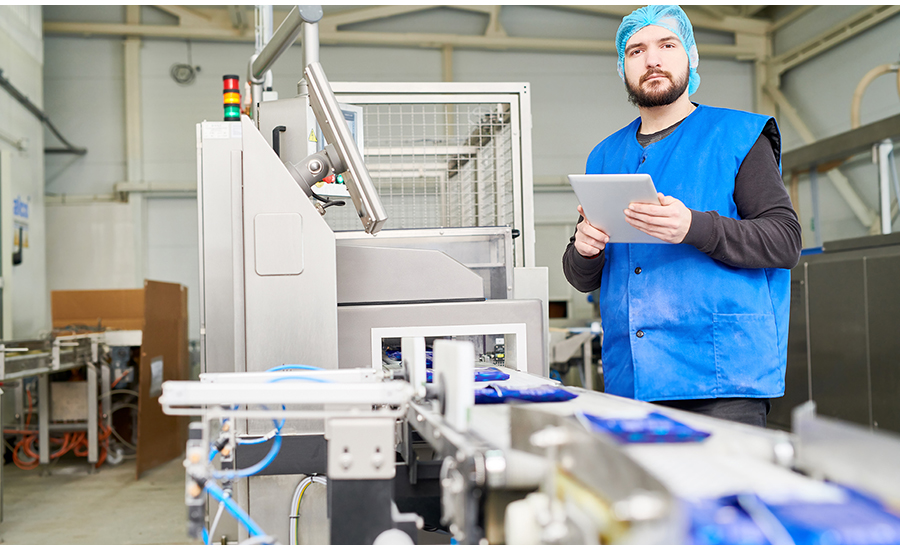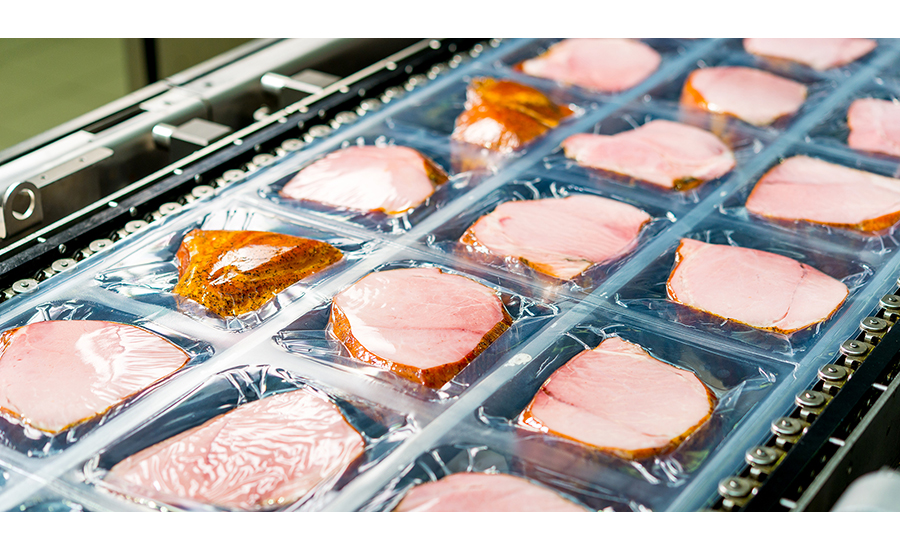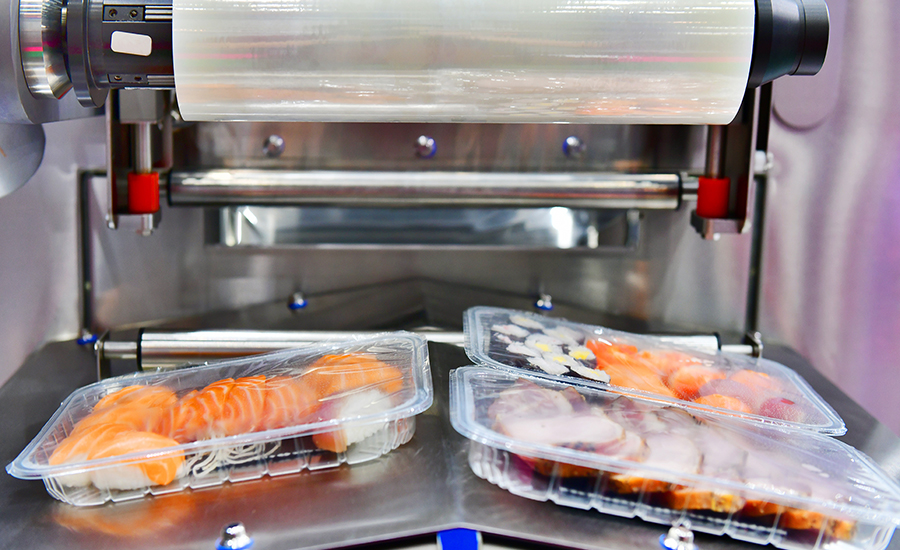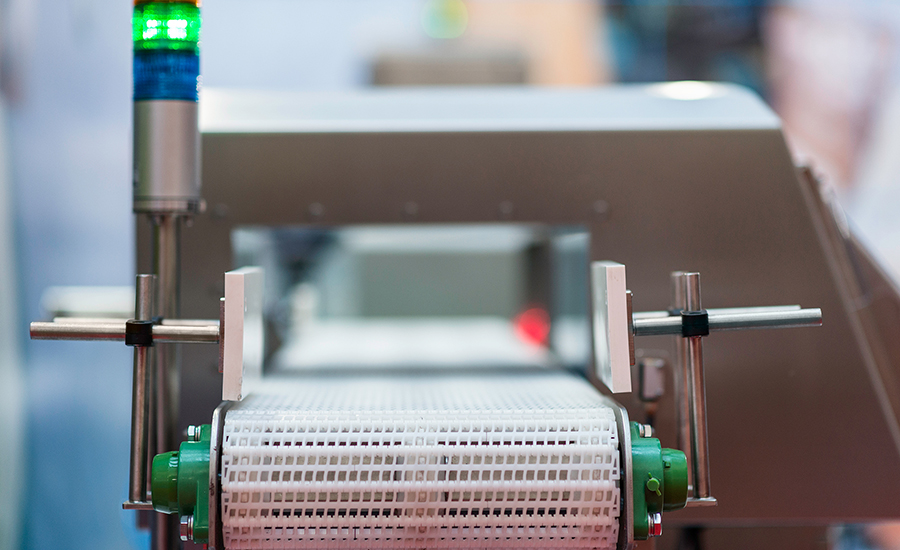Inspection / Detection
Foreign Matter Detection
Strategies for selecting a foreign material detection system

When it comes to foreign material detection in the food engineering space, different processes require different detection methods/equipment. Image courtesy of Getty Images/sale013.
When it comes to foreign material detection in the food engineering space, different processes require different detection methods/equipment. There are several types of systems that can help detect foreign material in a food process, among which are metal detectors, X-ray units and magnets.
To understand what method is suitable for a particular process, the first step is to review the facility’s written foreign material control program and understand how it is being executed. According to Bonnie Biegel, director of quality assurance, Americas, at AIB international, “A strong foreign material control program that adequately assesses risks, puts preventive controls in place to mitigate those risks, and is executed correctly by a trained team will minimize physical contaminants in products and reduce the risk of costly product recalls.”
Choosing the best system for a given facility should be based on a hazard analysis, Biegel notes, which will provide an understanding of the risks faced, and direct implementation of the necessary detection systems. “Each system is then most effective when used correctly as part of a food safety plan and overseen by a trained team,” she says.
Barry Voorhees, metal detection product manager at Bunting Magnetics, says that when a company approaches them for foreign material detection, the first step is to evaluate the process to understand it start to finish. This includes raw material entry points and equipment used, processing equipment from screeners, mixers, conveyors, etc. “This is to make sure we have a full understanding of their operation. Then we discuss their concern or problem areas. What CCPs (critical control points) do they have established and is there any existing equipment for foreign matter removal? Are they currently having any metal issues or is it a preventative measure to improve their protection?”

Eric Garr, regional sales manager at Fortress Technology Inc., agrees. “The first step we always take is to examine if they already have any specific contamination risks that they need to mitigate. This is then followed with a more comprehensive assessment, looking closely at each step in the production process, the associated contamination risks and then review the feasibility of using an inspection technology at the various steps.” He says that an on-site walk through of their process is generally the best way to identify the feasibility of adding inline detection.
Eric Confer, light industry market manager at Eriez, says that every inquiry they receive starts by asking what the target metal size is. “From there, through a comprehensive needs assessment, we determine what detector and installation is best suited to meet the stated sensitivity objectives.”
To design the best inspection solution for a given application, Jay Parekh, vice president of engineering at Peco InspX, says there are three key characteristics to understand: product, package and process. “The nature of the product will determine the baseline x-ray power needs and product characteristics we’ll be working with—liquid, solid, multiple ingredients, etc.,” he says. Next, the size and shape of the package (or lack thereof in the case of bulk ingredients inspection) helps them recommend the best angle of inspection—whether that be from the top, the side, a hybrid position in between, in a pipeline or even pulled on a packet web or bandolier.
“Lastly, an intimate understanding how the ingredients were processed and how the finished product is made helps us identify contamination risks along the way,” he says. “With this knowledge, we can ensure our solution is designed to identify these contaminants wherever they might be found in the container or product.”
Jeff Youngs, president and CEO of Prospection Solutions, says that they will work with a customer’s quality assurance department to review the types of foreign material that have been found in the process previously, or foreign material claims they have received from their customers.
They also review the customer’s process to better understand what foreign objects could make their way into the product stream. “Common culprits include broken conveyor belting, ripped bags and liners, and personal protective equipment (PPE),” he says. “We then perform testing on product provided by the customer to determine what foreign objects our foreign material detection system can reliably detect and report those findings back to the customer.”

Scott Ruttgaizer, product manager at P&P Optica, says that every facility they work with has unique needs and unique considerations in building or updating their foreign materials prevention program. “Understanding their context, risks, trade-offs and culture helps us make the best recommendations.”
First, assess the risks, Ruttgaizer says. “What are the risks of foreign materials contamination? What materials might be the most likely to be present? “Contaminants like metal may require a different inspection methodology than bone, plastics or rubbers. A multi-hurdle approach using multiple technologies may be required to give the best chance of finding all the materials that may be present in-stream,” he says.
Next, he says to consider the context. “It’s crucial to understand the context in which new equipment or a new process is being implemented. What product is being inspected, and at what point in the production process?” He says that understanding criteria for success is an important part of the context as well.
Managing trade-offs is key, too. A perfect inspection system would catch 100% of foreign materials, he says. “Unfortunately, a system that catches 100% of contaminants will also reject 100% of good product. So, each inspection system implemented in a processing plant will need to be tuned, considering the accuracy of the inspection, speed of processing and false positive rates,” he says.
Finally, understand culture. Ruttgaizer says the success of every new inspection system or process will depend on the people in the plant. “It’s imperative to understand and acknowledge the willingness of the operators and supervisors to adopt a new technology or a new approach. It’s also crucial to build in accountability and train the team to ensure success.”
AIB’s Biegel agrees that it is critical for manufacturers to understand that the foreign material detection equipment they choose is only as beneficial as the training they have provided their employees to use it and manage foreign material as part of their food safety plan. “For instance,” she says, “even the best metal detectors can be bypassed by an employee who places rejected product back on the line or turns off the metal detector or reject device when numerous rejects occur. The most important aspect of a foreign material detection policy is to educate employees about the significance of rejected materials and what the device is trying to tell them.”
Despite the use of foreign material removal devices in food processing, she says that employee training is one of the most effective ways to take control of this highly visible and potentially damaging issue. “By supporting employees with training to identify foreign material and improve their controls, companies can further reduce their risks.” AIB offers a foreign material control program assessment that helps identify gaps in written programs, evaluate employee practices and assess plant and equipment conditions, resulting in actionable recommendations that work for a specific facility.
Detection placement on the line
Where should foreign matter detection systems be placed on the processing line—as ingredients come in, throughout the process, at the end of the process, before or after packaging?
Again, because each facility’s risks are different, they will warrant a different series of controls. Biegel notes that to better understand the risks specific to their facility, food safety teams can use hazard analysis, which will help them discover how foreign materials may get into their products. Based on this assessment, they can develop an effective foreign material management plan that includes a series of preventive controls to address and mitigate the risks they found in receiving, throughout the manufacturing process and in packaging.
Many processors use a “start clean, stay clean” approach to foreign object detection, Ruttgaizer, says. “This means checking the incoming raw materials as they enter the plant. Many companies continue to inspect the product as it moves through the production process, and then perform end of line detection before product leaves the facility.”
While no single system is perfect, he says many processors recognize that using multiple systems can offer more certainty. “Much in the same way that doctors use different types of systems (such as X-rays, MRIs or CAT scans) to assess for different conditions, using a range of detection systems provides much more comprehensive insights. A multi-hurdle approach can be very effective, but does require a significant investment on the part of the company.”
Contaminant detection is important at every critical control point of the production process, according to Yuanjun Chloe Lu, product application specialist, product inspection, Thermo Fisher Scientific. “The top concern is always product quality compromise,” she says. “Additionally, foreign objects can create further damage to processing equipment, which could lead to production downtime, or even more foreign contaminants from equipment breakage.”
She uses an almond factory as an example. “Stones or metal shaving could come into the production plant along with freshly harvested nuts, which can potentially break down blending blades later in the process. In this case, product inspection equipment is recommended to be installed after raw material intake, post blending/flavoring equipment and after packaging to minimize potential foreign object contaminants.”
Guy Wheeler, key accounts manager at Anritsu, says to determine where detection is needed, companies should ask what the potential foreign material is. “If your product is a ground protein, both metal and bone are common issues,” he says. “Ideally, inspecting prior to the initial grind will reduce the amount of bone in finished product. Post-grind inspection for metal shavings would be a logical strategy before packaging.”

Bunting’s Voorhees says they recommend detection throughout the process—especially if the process uses any equipment that could have metal on metal contact such as augers, airlocks and hammermills. “If a customer currently has no foreign matter protection, then for brand protection we recommend metal detection at the end of the line either before packaging or after at the very least.”
He says they then work their way back through the process starting at material ingredient entry points to ensure their suppliers are providing clean product and accountability. Any areas where machine protection is critical or potential high wear areas where internal contamination can occur are also good placement.
Garr at Fortress says that end of line inspection after packaging or as close as possible to a fully packaged product is necessary to comply with HACCP and the various global food safety initiatives. “However,” he notes, “that will seldom tell users the original source of the metal contamination. There is always value to be gained from adding upstream detection systems to most processes.”
Incoming materials should be inspected when leaving the supplier, but this may not be guaranteed, he points out. “Catching contaminants sooner may mean a single reject of a relatively easy-to-detect contaminant vs. a higher number of downstream rejects on packaged finished products. Rejecting at the end of the line is typically the most expensive place to remove the metal from good product streams.”
Factoring in HARPC and recognizing there are specific risks at different steps in the process is a smart approach, Garr says. Detection upstream often makes it easier to detect contaminants, trace to their source and potentially alert staff to equipment failures before they become catastrophic.
Todd Grube, product manager, inspection systems, Heat and Control, agrees that the chance of locating foreign matter increases with each opportunity to inspect the product. However, budget is a key factor in determining which points along the processing line are inspected. “Ideally, at a minimum, inspection at the beginning and end is advised; the beginning so that foreign material from the raw materials is eliminated and is not broken down into harder-to-detect sizes, and the end so that foreign matter from the processing machinery is found and as a final checkpoint before the product enters the marketplace.”
Inspecting ingredients upon receiving allows customers to verify that products are clean as they enter their facility for further processing.
Ray Spurgeon, metal detector product manager at Eriez, says that metal detection should be used throughout the entire process—especially at the beginning. “This is particularly important if blending or other process equipment is used prior to packaging that can fragment one large piece of metal into thousands of smaller pieces.” He recommends inspecting finished product after it is packaged to avoid metal contamination from equipment and sabotage.
Sarrina Crowley, marketing communications manager at Mettler-Toledo, adds that systems should be placed at each CCP throughout the line. “At each stage, value is continuously added to the product, so detection early not only ensures safety but also saves costs and rework,” she says.
Kyle Knudsen, vice president of technology at Prospection Solutions, explains that inspection for foreign objects is beneficial throughout the production process, but there are a couple of locations that have distinct advantages for a customer.
Inspecting product as it is received allows the customer to hold their suppliers accountable for any foreign objects that are detected at that point in the process, he says. This also allows the customer to verify that the product is clean as it enters their facility for further processing.
“Inspecting product before grinding or any other destructive process is also an optimal time for inspection,” Knudsen notes. Foreign objects that undergo a destructive process will break apart creating more foreign objects that are now smaller and more challenging to detect.
Finally, inspecting product before packaging can ensure that product is clean directly before it is packaged and sealed. “This is also the last point where a thorough inspection of the product for low-density foreign objects can be completed,” he says.

Biegel adds that the specific foreign material detection equipment chosen should be based on the risks found during the hazard analysis, with the goal of effectively reducing these risks throughout the manufacturing process. “For instance, if a site uses vibratory conveyors, constructed of non-ferrous metal, where misalignment of the overlap of the sections of the conveyor can cause metal shavings through wear, a metal detector or X-ray machine with the capability to detect non-ferrous metal may be the best choice in identifying this issue. Magnets would not be effective in detecting wear of non-ferrous metals and would not be a good solution in this instance.
“Too, the products being manufactured, processes being used, and even the environment they are in may affect how each of piece of detection equipment works and impact its ability to function correctly. Work with both the processing equipment manufacturer and the foreign material detection equipment manufacturer to better understand these impacts and how to choose the equipment that’s right for the facility and how to get the most out of it.”
Food for thought
Foreign material is the third leading cause of product recalls in the United States, Biegel says, so it is critical that it is included as part of the food safety plan. “A good plan that is executed well will minimize the manufacturer’s risk of food contamination and help exceed their customers’ expectations for food safety and quality.”
Also, there is not a one-size-fits-all solution to foreign matter removal. “There are a lot of different types and styles or equipment to handle different processes and material types,” says Vorhees. “We also provide material testing in our Customer Experience Center for our customers. This can be done on anything from raw ingredients to final products to ensure we are applying the right product in the right application.”
Wheeler notes that because the equipment typically runs for many years, it is important to factor in long-term total cost of ownership. “In addition to the equipment purchase, consider reliability, cost of replacement parts, service response time and cost, and savings from reducing false positives and rework,” he says.
Consult with experts that have the capacity to offer product testing services to ensure that the equipment offering is not oversold on technology, features and/or performance that will not be feasible for your specific application, Garr says. “In almost every application, it is the product that will ultimately determine what is possible in terms of contaminant detection. Suppliers that offer this type of service will typically provide a performance guarantee.”
Sometimes, a manufacturer wants to save money and use only one technology and/or wants to inspect fewer points along the processing line, Grube explains. “The reputation of a company is at stake with each item that a food manufacturer puts into the marketplace. The time, effort and resources invested to create a well-received product can evaporate if consumer trust is broken,” he says. “With a consumer able to use social media to quickly publicize a single experience, it is critically important to make sure each experience is positive.”
He adds technology in inspection and detection equipment continues to advance, so food processors readily can improve their quality control programs and utilize more sophisticated inspection equipment that detects smaller foreign objects, reduces false rejects and handles a wider range of products to ensure maximum food safety with higher productivity.
Jeff Rowen, vice president of sales and customer relations at Prospection Solutions, says a key part of selecting and purchasing equipment is making sure the equipment both meets a facility’s needs and is well supported. “The machine should be easy to operate, maintain and clean,” he says.
Parekh says it is critical that manufacturers consider the significance of full-container inspection in their quality programs. “This ensures that any defects in the container itself—as well as foreign material detection—are flagged for review or ejection.” He adds that another key element to consider in equipment selection is whether the machines are future-proofed for Industry 4.0 intelligence and communication protocols. “Historically, OEMs have digitized their equipment but often their data and information remains siloed. Now we’re moving towards an interoperable world where this data transmission is electronic and instantaneous. Equipment like x-ray inspection systems should be able to monitor and broadcast data throughout the SCADA systems, as well as new cloud production and management layers.”
Ruttgaizer piggybacks on that. “While artificial intelligence (AI) is still a relatively new technology for the food sector, we are very excited about its potential to provide insights across the whole food chain—from farm to fork.” He says the ability to gather data at line speed and analyze it quickly means processors can now access information about products passing through their plants in real-time. “This allows them to see trends in quality and composition.”
NEXT: Foreign Matter Detection Product Roundup
Looking for a reprint of this article?
From high-res PDFs to custom plaques, order your copy today!






